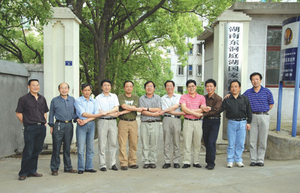Dongting Lake Observation and Research Station of Wetland Ecosystem has being founded from 2005. The predecessor is Dongting Lake Station, founded in 1978. The focal research fields include as follows: observing the structures, processes and functions of wetland ecosystems, investigating the driving mechanism of succession, and constructing the models of sustainable utilization of wetland resources and the optimization of wetland service functions.
 |
 |
| Experts reviewing the sites of the station | Cooperative partners |
Dongting Lake Station located in South bank of Caisang Lake, suburb of Yueyang City, Hunan Province (29o30′N,112 o48′E ), 180 KM away from Changsha, capital city of Hunan Province. The station is one of the long-term research bases for lake wetlands ecosystems, deployed at the middle and lower reaches of Yangtze River by the Chinese Academy of Sciences.
Dongting Lake is in the transitional zone of middle subtropic and north subtropic climate. The annual mean temperature is 16.4-1 7.0 °C, the annual precipitation 1200-1500 mm, and frost free period 258-275 days. The core area of Dongting Lake ecosystem is water body, extended into beach, plain, hills, and mountains, showing dish-shape landscape with vertical zonation. Wetland ecosystems can be classified into the following types according to physiognomy: (1) rive ecosystem; (2) freshwater lake ecosystem; (3) shallow water ecosystem (including strand, meadow, grassland, woodland); (4) mesic forest ecosystem; (5) wetland agro-ecosystem. Both plant species diversity and biomass are high. The environment is highly heterogeneous and different plant communities are formed in specific habitats. Aquatic vegetation formed in water bodies, consisted mainly of emerged, floated, and submerged plant communities. Meadow and marsh vegetation formed in beach and lower plain, consisted of rhizomatous carex, grasses, and xeric ruderals brought by floods. Evergreen broad-leafed forests formed in surrounding plains and hills. Fluro-aquic and paddy soil are formed by sedimentation brought by floods. The soil layer is deep and pH value ranges from neutral to alkalescent.